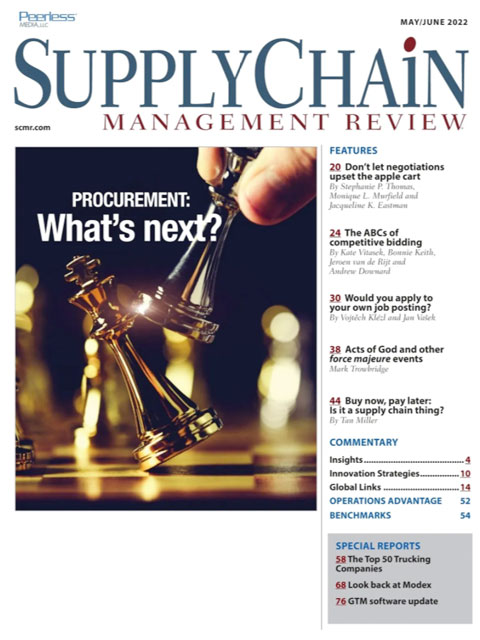Sorry, but your login has failed. Please recheck your login information and resubmit. If your subscription has expired, renew here.
May-June 2022
I recently returned from three days in Atlanta at the Modex trade show. Although advertised as a supply chain event, it’s really a materials handling automation show with a handful of logistics providers thrown in for good measure. Heading out the door to the airport, I had no idea what to expect. The two-year absence from the trade show and conference scene had me, and many of the individuals I spoke to before the show opened, wondering what’s next—not just for the show but for operations in general. If the turnout and the enthusiasm is any indication, I think supply chain is in pretty good shape these days, despite the disruptions we’ve… Browse this issue archive.Need Help? Contact customer service 847-559-7581 More options
Let’s say that you’re the manager of logistics for a major retailer. Led by the sales and marketing groups, your firm has recently implemented the latest rage in e-commerce and retail purchasing practices, “buy now, pay later,” or what we’ll call BNPL. The program allows consumers to make a purchase and receive the merchandise today while making payments over time. Of course, these programs have been around for years. Backed by finance companies, they’ve typically been offered by companies and services providers with expensive products that people used to spend years saving up for, everyone from your local dentist to finance expensive dental procedures like crowns and veneers to furniture retailers. Today, these programs have gone mainstream: Use your Paypal account to buy a $60 pair of shoes online, and Paypal is likely to give you the option of paying for the purchase over four payments to six payments.
It’s easy to see why sales, marketing and finance might love these programs because they potentially open up a new sales channel and increase revenue. But what about supply chain? Perhaps it’s not as simple as it seems on the surface and creates a new set of logistics costs and headaches.
Over the years, you, the supply chain manager, have made the accommodations necessary to facilitate a lay-a-way purchase. When a customer purchases via lay-a-way, you put the item aside in your warehouse or the back room of a store, and then ship the item to the customer, or they pick it up in the store, after the final payment is made. You have to create additional storage space and perhaps a carry cost to hang on to the item. But, if they customer fails to make the final payment, the item can still be resold as new.
The BNPL is similar, but different. Now, when the customer clicks the purchase option after agreeing to make payments, they take immediate possession of the item, either picking it up in a store, or after you ship it out to them. That sounds simple enough. But, one of the things you noticed is that not infrequently, the customer changes their mind, cancels the BNPL contract, and returns the item to your distribution network, just like they’d return any other product. Sometimes, the returns don’t come back for weeks, or even months, after they’ve been used by the customer for some period of time in their homes. What’s more, as the volume of e-commerce orders has picked up, so has the volume of returns, including those purchased using BNPL.
These returns come back in various used states. In some cases, the products can no longer be sold again, even on a discounted, used basis. As a logistics manager, you find yourself wondering whether the BNPL purchase option is actually helping or hurting your firm’s financial success, if you take into consideration all of the costs associated with handling, returning and potentially disposing of the product.

This complete article is available to subscribers only.
Log in now for full access or start your PLUS+ subscription for instant access.
SC
MR
Sorry, but your login has failed. Please recheck your login information and resubmit. If your subscription has expired, renew here.
May-June 2022
I recently returned from three days in Atlanta at the Modex trade show. Although advertised as a supply chain event, it’s really a materials handling automation show with a handful of logistics providers thrown in… Browse this issue archive. Access your online digital edition. Download a PDF file of the May-June 2022 issue.Let’s say that you’re the manager of logistics for a major retailer. Led by the sales and marketing groups, your firm has recently implemented the latest rage in e-commerce and retail purchasing practices, “buy now, pay later,” or what we’ll call BNPL. The program allows consumers to make a purchase and receive the merchandise today while making payments over time. Of course, these programs have been around for years. Backed by finance companies, they’ve typically been offered by companies and services providers with expensive products that people used to spend years saving up for, everyone from your local dentist to finance expensive dental procedures like crowns and veneers to furniture retailers. Today, these programs have gone mainstream: Use your Paypal account to buy a $60 pair of shoes online, and Paypal is likely to give you the option of paying for the purchase over four payments to six payments.
It’s easy to see why sales, marketing and finance might love these programs because they potentially open up a new sales channel and increase revenue. But what about supply chain? Perhaps it’s not as simple as it seems on the surface and creates a new set of logistics costs and headaches.
Over the years, you, the supply chain manager, have made the accommodations necessary to facilitate a lay-a-way purchase. When a customer purchases via lay-a-way, you put the item aside in your warehouse or the back room of a store, and then ship the item to the customer, or they pick it up in the store, after the final payment is made. You have to create additional storage space and perhaps a carry cost to hang on to the item. But, if they customer fails to make the final payment, the item can still be resold as new.
The BNPL is similar, but different. Now, when the customer clicks the purchase option after agreeing to make payments, they take immediate possession of the item, either picking it up in a store, or after you ship it out to them. That sounds simple enough. But, one of the things you noticed is that not infrequently, the customer changes their mind, cancels the BNPL contract, and returns the item to your distribution network, just like they’d return any other product. Sometimes, the returns don’t come back for weeks, or even months, after they’ve been used by the customer for some period of time in their homes. What’s more, as the volume of e-commerce orders has picked up, so has the volume of returns, including those purchased using BNPL.
These returns come back in various used states. In some cases, the products can no longer be sold again, even on a discounted, used basis. As a logistics manager, you find yourself wondering whether the BNPL purchase option is actually helping or hurting your firm’s financial success, if you take into consideration all of the costs associated with handling, returning and potentially disposing of the product.
SC
MR


More Finance
- Investor expectations influencing supply chain decision-making
- ISM reports manufacturing sees growth in March, snaps 16-month stretch of contraction
- Supply Chains Facing New Pressures as Companies Seek Cost Savings
- February retail sales see annual and sequential gains, reports Commerce and NRF
- A New Model for Retailer-Supplier Collaboration
- How to Create Real Retailer-Brand Loyalty
- More Finance
Latest Podcast

 Explore
Explore
Topics
Business Management News
- Few executives believe their supply chains can respond quickly to disruptions
- Technology’s role in mending supply chain fragility after recent disruptions
- Survey reveals strategies for addressing supply chain, logistics labor shortages
- How CPG brands can deliver on supplier diversity promises
- How S&OP provides the answer to in-demand products
- AI, virtual reality is bringing experiential learning into the modern age
- More Business Management
Latest Business Management Resources

Subscribe

Supply Chain Management Review delivers the best industry content.

Editors’ Picks






